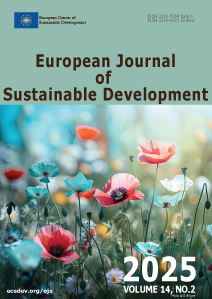Study on Photocatalytic Degradation of Rhodamine B by Modified Red Mud Catalyst with Biochar
DOI:
https://doi.org/10.14207/ejsd.2025.v14n2p877Keywords:
red mud, biochar, photo-FentonAbstract
In this work, a red mud(RM)-coffee grounds(CGs) pyrolysis composite material (RC-PC) was prepared and applied to the study of photocatalytic Fenton degradation of organic pollutants. The results of SEM, TEM, and XRD analyses show that during the pyrolysis process, the coffee residue is transformed into biochar with a porous structure, and the hematite in the RM is stepwise reduced to Fe3O4 and Fe0. In the experiment of degrading Rhodamine B (RhB) under simulated visible light conditions, after 30 minutes of reaction, RhB exhibited a degradation efficiency of 94.8% in the light condition, significantly surpassing the 48.8% efficiency observed in the dark Fenton system. Radical quenching experiments and EPR analysis confirmed that hydroxyl radicals (•OH) produced by Fe2+-mediated H2O2 activation in the photocatalytic Fenton system dominate the degradation of RhB. The results of photogenerated electron-hole quenching experiments indicate that photogenerated holes directly participate in the degradation of RhB by oxidizing OH? ions to generate •OH radicals, and photogenerated electrons participate in the reaction process by promoting the Fe2+/Fe3+ cycle. Iron leaching from the catalyst induces a homogeneous degradation pathway primarily mediated by Fe2+ species during the reaction.
Keywords: red mud; biochar; photo-Fenton
Downloads
Published
How to Cite
Issue
Section
License

This work is licensed under a Creative Commons Attribution-NonCommercial 4.0 International License.





